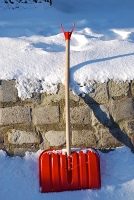 For a West Coast transplant on the East Coast, the act of “snow removal” has created some fascinating sightseeing in recent weeks. Think: dump trucks zooming by hauling snow to a “snow farm.” Yes, that’s an actual place. According to news reports, the piles at one “snow farm” are now more than five stories high. Think: gargantuan orange municipality trucks plowing residential streets while simultaneously depositing snow in driveways that were just shoveled. Think: the sound of snow blowers at 7am. On a Saturday. Think: actually seeing a snow blower in action. Think: my gratitude (so much gratitude!) for the hubster who shovels our driveway (the snow blower of our dreams is, yes, currently out of stock). And as I’ve watched these scenes over and over again in recent weeks, I’ve been thrilled to recognize that each happens as a result of organization: municipally, residentially, and logistically speaking.
For a West Coast transplant on the East Coast, the act of “snow removal” has created some fascinating sightseeing in recent weeks. Think: dump trucks zooming by hauling snow to a “snow farm.” Yes, that’s an actual place. According to news reports, the piles at one “snow farm” are now more than five stories high. Think: gargantuan orange municipality trucks plowing residential streets while simultaneously depositing snow in driveways that were just shoveled. Think: the sound of snow blowers at 7am. On a Saturday. Think: actually seeing a snow blower in action. Think: my gratitude (so much gratitude!) for the hubster who shovels our driveway (the snow blower of our dreams is, yes, currently out of stock). And as I’ve watched these scenes over and over again in recent weeks, I’ve been thrilled to recognize that each happens as a result of organization: municipally, residentially, and logistically speaking.
As our nation learned from the lack of snow removal in New York City after a hefty December 2010 snow storm, the activity of having a municipality remove snow, plow streets, and otherwise “shovel out” requires a level of organization akin to planning the Super Bowl, a university graduation, or a similar large scale event. Well, not really. But it does require plenty of advance planning, back-up plans, a robust store of supplies, skilled people power, flexibility, and in some states, pickle juice. Last month, in response to the December snow mishaps, New York City put GPS trackers in trucks assigned to plow out the city so they could dispatch them to the neighborhoods where they were most needed. The city had extra people on-staff and trucks widely dispersed. And, according to some friends who live in New York City, these doubled-up efforts made all the difference.
In my neck of the woods a few hours from New York City, I’ve found that individuals have their own ways of organizing a “shovel out” experience on their private properties. Some choose to remove snow from their driveways methodically, from left to right. Others choose to snow blow or “shovel out” from the end of the driveway in, and others simply choose to fling snow any which direction – as long as it’s reasonably out of the way. As with anything, with snow removal you have to find what works for you. And when you stick to what works for you, all is well with the world and the white stuff that’s enveloping everything around you. And yes, that could mean hiring a landscaper to plow you out, doing it yourself, or having a loved one do it for you while you take care of things inside your house.
Although he’s not a professional snow plow contractor or certified snow remover (I don’t think that’s an actual certification, although he really has earned this certification with his snow removal activities this winter), the hubster offers the following tips for people like me – transplants who could use some nifty snow removal tips right about now:
- Wear waterproof gloves, a hat, layers of warm clothing, and a good pair of boots
- Consider buying a snow blower if you reside in an area that regularly sees snow storms packing more than a few inches of snow. Tip: make this purchase before the first big storm of the season. As we have learned this season, when stores are out of stock, they’re out of stock.
- Take breaks while shoveling. And work methodically.
- If the snow is heavy, don’t try to lift too much at once. A little at a time will go a long way.
* Photo by Mattox



